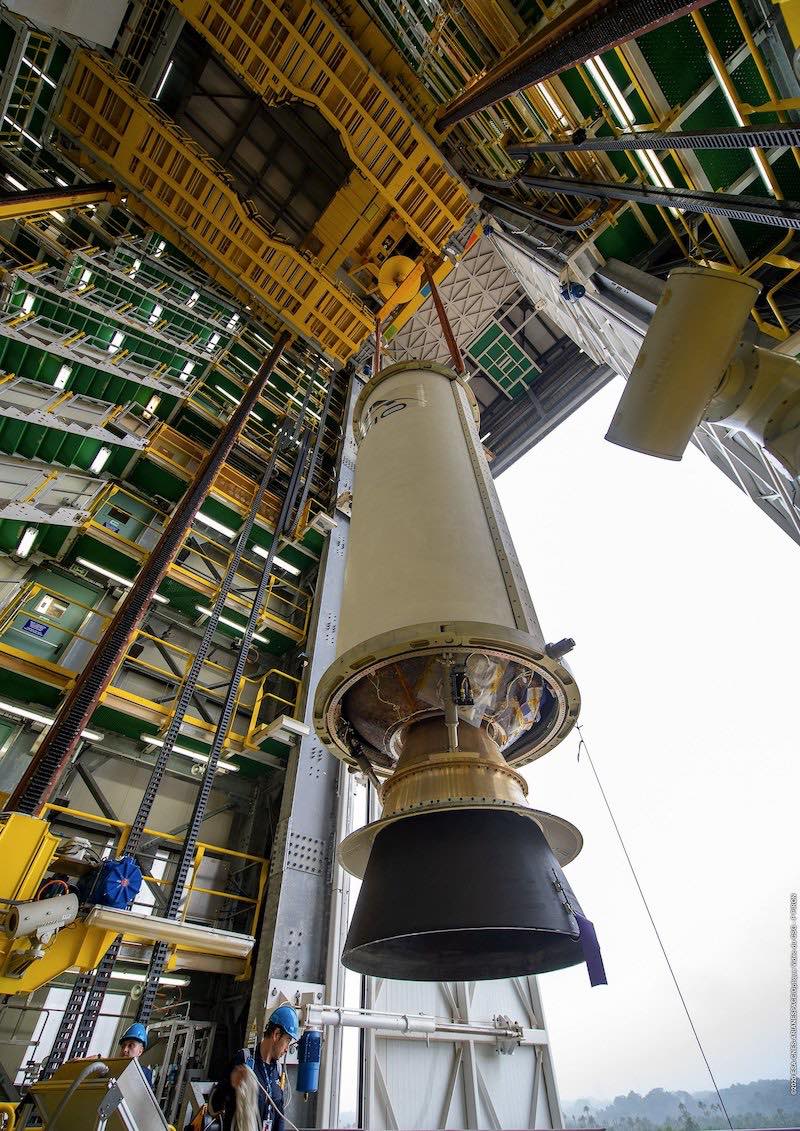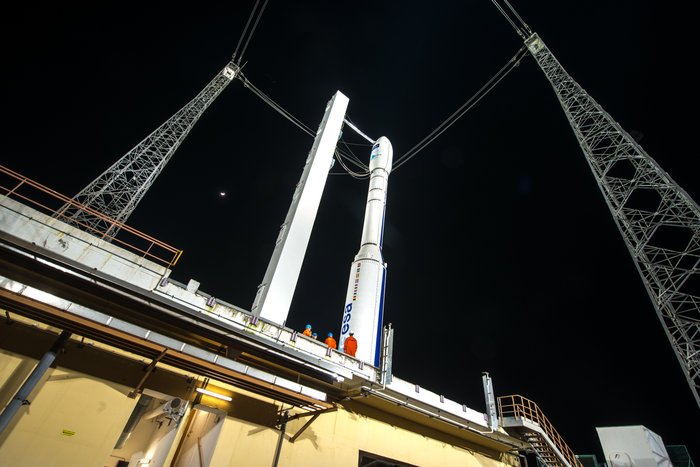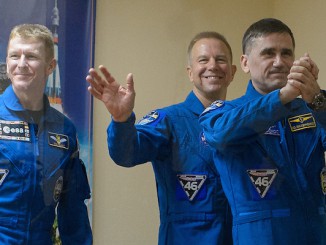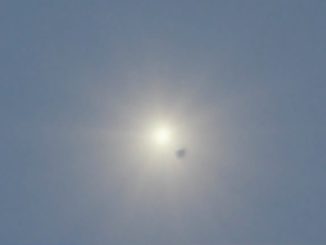
The head of Italian rocket-maker Avio said Thursday that preparations are proceeding without interruption for the launch of a Vega rocket later this month in French Guiana, but officials have adjusted work schedules at the company’s Vega manufacturing plant near Rome in response to the coronavirus outbreak.
Teams are preparing the Vega rocket for its first flight since a launch failure last July that destroyed a military reconnaissance satellite for the United Arab Emirates. It was the first failure of a Vega rocket in 15 flights since it debuted in 2012.
The Vega launcher, primarily built in Italy by Avio, is scheduled for liftoff at 9:51 p.m. EDT on March 23 (0151 GMT on March 24) from the Guiana Space Center on the northeastern coast of South America.
Giulio Ranzo, Avio’s chief executive, said in a phone interview Thursday that preparations for the launch March 23 are continuing on schedule in French Guiana. Ground teams needed to ready the Vega rocket for flight are in place at French-run space base.
“The team has been gathered in Kourou now starting from two months ago, and the last few guys went last week, so I think we’re all set,” Ranzo said. “The whole team is there. It’s not clear when they will come back, but that’s another story.”
Governments around the world have introduced travel restrictions in an attempt to slow the spread of the coronavirus pandemic, and it’s not clear how limits on travel may change in the coming weeks. Italy has been the hardest-hit country in Europe by the COVID-19 viral disease, and the Italian government has locked down travel into and out of the country.
As of Friday, Italian authorities have reported 1,266 deaths in the country from COVID-19.
Arianespace, the French launch services provider, oversees Vega launch operations after Avio teams assemble and test the rocket. Arianespace has mission managers and engineers permanently stationed in French Guiana, an isolated coastal French territory between Suriname and Brazil.
Another Vega launch is scheduled for June from French Guiana, and Ranzo said Avio’s team could start work on the next launch campaign if they remain in French Guiana.
“In any event, we have another flight coming up next, so we can make use of the people also immediately after this flight,” Ranzo said. “So we will adapt the schedule to what we can do.”
French health officials have reported five confirmed COVID-19 cases. Last week, spaceport officials there said the space center’s museum, public tours and public viewing sites for upcoming launches would be closed until further notice.
The four-stage Vega rocket has been stacked on its launch pad at the Guiana Space Center, and the 44 satellites that will ride the launcher into orbit have been integrated with a multi-payload dispenser for encapsulation inside the Vega’s aerodynamic nose shroud.
The payload fairing containing the 44 satellites will be raised atop the Vega rocket in the coming days to cap assembly of the 98-foot-tall (30-meter) vehicle.

The rideshare mission is the first flight of the Small Spacecraft Mission Service, or SSMS, platform designed to accommodate dozens of microsatellites and CubeSats on a single launch.
Development of the SSMS carbon fiber dispenser was started by the European Space Agency in 2016. The first SSMS launch, designated as a “proof of concept” flight, will carry 44 satellites into orbit, ranging in mass from 1 kilogram (2.2 pounds) to nearly 400 kilograms (about 900 pounds), officials said.
Arianespace sold capacity on the Vega rocket to satellite operators and launch brokers, such as Seattle-based Spaceflight, Innovative Solutions in Space of the Netherlands, and D-Orbit of Italy. In the end, Arianespace and the launch brokers signed contracts to launch 44 spacecraft on the SSMS proof of concept mission.
“We just finished integration of all of the payloads together,” Ranzo said. “There are 44 of them, so it was quite some work in the payload processing facility. The launcher is integrated on the launch pad. It takes (some) days for electrical checks, for filling up the upper stage fluids, and so on.
“But most of the work has been completed,” Ranzo said. “So a number of question marks always remain, like weather conditions and high-altitude winds, stuff like that. But other than that, I think we’re good to go.”
Ranzo said the Vega launcher’s upper stage will perform numerous small maneuvers to deploy the 44 satellites into polar sun-synchronous orbits at two different altitudes a few hundred miles above Earth.
The mission later this month will carry more satellites into orbit than any previous European rocket launch. The record number of satellites ever carried on a single rocket launch is 104, a mark set in 2017 on a flight by India’s Polar Satellite Launch Vehicle.
“We have SuperDoves from Planet, we have Spire on-board, we have GHGSat from Canada, we have some from the European Commission,” Ranzo said. “We have a whole bunch of customers coming from all over the world, so not bad. It’s fully loaded. We basically have no room left for additional payloads. It’s the first time in Europe that we do a massive rideshare which has such a different in satellites from the size of one to the size of another.”

Avio and Arianespace are planning more SSMS rideshare missions, beginning in late 2021 or early 2022 with the SSMS 2 mission on a Vega C rocket. The Vega C is an upgraded version of the Vega rocket scheduled to launch for the first time later this year.
The launch set for March 23 will end an eight-month grounding of the Vega rocket to allow engineers to investigate the cause of the Vega failure last July.
Investigators determined super-hot gas from burning solid propellant impinged on the structure of the Vega rocket’s Zefiro 23 second stage on the mission last July, resulting in a “thermo-structural failure” on the second stage’s forward dome.
The hot gas, which burns at more than 5,000 degrees Fahrenheit (3,000 degrees Celsius), damaged or burned through the carbon fiber structure on the second stage. The structural failure led to the in-flight breakup of the launch vehicle with the UAE’s Falcon Eye 1 spy satellite.
According to Ranzo, engineers concluded a “manufacturing anomaly” slipped through Avio’s quality control checks.
“We had thermal protection (on the second stage) where the thickness was perhaps less than one millimeter short, so we had a very, very tiny deviation that was undetectable to all the quality checks,” Ranzo said Thursday.
“So what we have done is we have greatly improved the technologies to allow for the manufacturing quality controls — using not only ultrasound but also digital radiography — in a much finer way with respect to work we used to do in the past,” Ranzo said.
Avio pulled hardware from the company’s Zefiro 23 production line in Italy, ran it through the improved quality control checks, and successfully test-fired the rocket motor at a test site in Sardinia.
“We test-fired a Zefiro 23 without any modifications,” Ranzo said. “But we picked one from production that we subjected to a much deeper quality control. So what we tested was our ability to detect a manufacturing production defect at a much finer level.”
Ranzo said Avio also added extra thermal insulation on the Zefiro 23 second stage motor.
“It’s probably not necessary, but we increased the safety margin,” he said. “So we are now approaching the flight with much better comfort with respect to safety.”
Engineers also modified parts of the Vega’s telemetry, flight safety and self-destruct devices, Ranzo said.
“We took the opportunity to increase the safety margin at a general level all across the launcher,” he said. “So we introduced some video cameras on-board to acquire more data and other sensors to continue monitoring exactly what happens, and continue learning as we go.
“I would say what came out is a launcher that is better and is updated with respect to what we had in the past, not only for the Zefiro 23 but also beyond.”
Avio factory in Italy impacted by coronavirus concerns, but rocket production continues
Avio’s Vega rocket manufacturing site in Colleferro, Italy, remains open as the growing coronavirus outbreak affects a wide range of businesses.
Ranzo said he was not aware of any Avio employees who have tested positive for the COVID-19 viral disease.
“It’s challenging, but so far, so good,” he said Thursday. “We implemented cautionary measures of all different kinds in the plant, and the offices.
“We’re doing remote working partly, and in the plant we’re obviously making use of all the individual protection devices to allow for production to continue,” Ranzo said. “The reality of things is that our production do not provide for people to be very close to each other, so we can maintain very large distances among people, and we can protect them.”
Work at the Colleferro plant, located around 30 miles (50 kilometers) southeast of Rome, is being spread across multiple shifts 24 hours per day “in a way that we don’t have too many people in the same place at the same time,” Ranzo said.
“So I would say so far, so good, with some challenges,” he said. “But it’s a global emergency.”
Production of hardware for the first flight of the upgraded Vega C rocket is also continuing at Colleferro, according to Avio.
“So far, it’s continuing OK,” Ranzo said. “I honestly cannot predict. At this time, all the markets around the world are impacted by what is happening. So it’s difficult to imagine what happens with a global event like this one.”
The first flight of the Vega C rocket is scheduled later this year. The Vega C will debut larger first and second stage rocket motors to loft heavier payloads into orbit, and the Vega’s Swiss-made payload shroud diameter will increase from 8.5 feet (2.6 meters) to 10.8 feet (3.3 meters), giving the Vega C double the payload volume as the first-generation Vega design.
The Vega C’s payload capacity to a 435-mile-high (700-kilometer) reference orbit will be 4,850 pounds (2.2 metric tons), an increase over the current Vega’s ability to carry around 3,300 pounds (1.5 metric tons) to the same orbit.
“This year is a year which is a bit difficult to plan at this point,” Ranzo said. “The final review of Vega-C development is in progress. It’s what we call the ground qualification review. It’s the time where you put together all the subsystems and you check that everything works.
“This is in progress,” Ranzo said. “It will probably go on until June, and then we should be — in principle — ready to fly by September. But the actual flight date I don’t know. It could be anywhere from September to December, depending on how we fit in the manifest, and how it will be end up being affected by inevitable disruptions.”
Email the author.
Follow Stephen Clark on Twitter: @StephenClark1.



